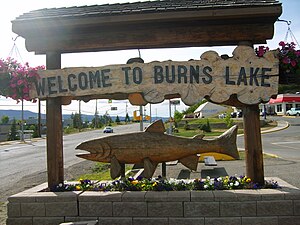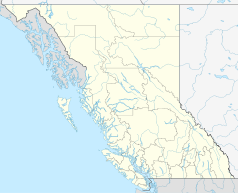Burns Lake, British Columbia
| Burns Lake | ||
|---|---|---|
 Burns Lake town center |
||
| Location in British Columbia | ||
|
|
||
| State : |
|
|
| Province : | British Columbia | |
| Regional District : | Bulkley nechaco | |
| Coordinates : | 54 ° 14 ′ N , 125 ° 46 ′ W | |
| Area : | 6.59 km² | |
| Residents : | 1779 (as of 2016) | |
| Population density : | 270 inhabitants / km² | |
| Time zone : | Pacific Time ( UTC − 8 ) | |
| Postal code : | V0J | |
| Foundation : | 1955 ( incorporated ) | |
| Mayor : | Luke Strimbold | |
 Entrance sign to Burns Lake |
||
Burns Lake is a small community in British Columbia ( Canada ), which was established in 1923. Burns Lake is the headquarters of the Regional District of Bulkley-Nechako .
geography
Burns Lake is within a 90-kilometer radius in the geographic center of British Columbia. It is approximately 500 kilometers from the Alberta border, 1,000 kilometers from the Yukon border and 1,000 kilometers from the United States. Burns Lake is 220 kilometers west of Prince George , the nearest major city, and is connected to it by Highway 16 . From there you can also get to Prince Rupert in the west via Smithers and Terrace (approx. 500 kilometers away). Burns Lake has an intersection where Highway 35 (second category highway) merges with Highway 16. Highway 35 continues south, via the small village of Tchesinkut Lake to François Lake , from where you can take a car ferry to Southbank .
Local division
Burns Lake has two different geographic areas. One part of the city is north of Francois Lake near Highway 16. The other part is south of the lake. Most of the shops and services are located in the north, while the south side is more dominated by ranches, where mainly cattle and horses live. Residents live in both areas, although the south side has more of a laid-back reputation. There are residential areas in both areas. The districts are connected by a car ferry, which takes about 20 minutes.
Near or in Burns Lake, the following First Nations of the tribal group commonly referred to as Dakelh have their administrative headquarters and / or main towns: Wet'suwet'en First Nation, Lake Babine Nation, Cheslatta Carrier Nation, Ts'il Kaz Koh First Nation (also Burns Lake Indian Band ), Skin Tyee First Nation and Nee-Tahi-Buhn Band.
history
One of the founders of Burns Lakes was Bob Gerow, who together with a partner ran a company at its current location. For this reason, there was already a trade route at the site of today's town center in 1911, as well as a bridge that connected Gerow Island with the mainland. The first newspaper in Burns Lake was called "Observer", it was distributed by Sidney Gowin.
The granting of local self-government for the community took place on June 2, 1955 ( incorporated as Village ).
Demographics
The last official census , the 2016 Census , showed a population of 1,779 inhabitants for the municipality, after the 2011 census showed a population of 2,029 inhabitants for the municipality. Compared to the last census in 2011, the population increased by 12.3% and thus again developed strongly against the provincial average, there with a population increase of 5.6%. In the census period 2006 to 2011, the population in the municipality had already decreased by 3.7%, while the provincial average increased by 7.0%.
At the 2016 census, the average age of the residents was 39.0 years, well above the provincial average of 42.3 years. The median age of the residents was determined to be 37.3 years. The median age of all residents in the province in 2016 was 43.0 years. For the 2011 census, a median age of 34.4 years was determined for the inhabitants of the municipality, and 41.9 years for the inhabitants of the province.
climate
The seasons in Burns Lake are usually structured as follows:
- Spring (April to May) : average temperature approx. 6 ° C, low precipitation
- Summer (June to August) : Average temperature 16 ° C, mostly rather dry
- Autumn (September to October) : Average temperature 7–8 ° C, less rain than in summer, e.g. T. first snow
- Winter (November to March) : Average temperature –10 ° C, e.g. Sometimes even temperatures around -30 ° C, dry
Burns Lake's average annual rainfall is 18 inches. The vegetation in the area around Burns Lake is forested, only around the settlements are meadow areas. Mainly spruce and pine dominate.
economy
Most of the people in and around Burns Lake make a living from forestry, farming, or tourism. Despite the low population density of Burns Lake, there is a secondary school, various shops, a library and a hospital in town. This is mainly due to the fact that Burns Lake is the main economic center of the surrounding region ("Lake District"). In terms of employment, the construction and wood processing industries are the largest branches of employment.
The median income of all Burns Lake workers in 2005 was well below average C $ 21,171 , while at the same time the average for the entire province of British Columbia was C $ 24,867. The percentage difference in income between men (C $ 29,669; provincial average = C $ 31,598) and women (C $ 17,876; provincial average = C $ 19,997) in Burns Lake, based on the average income of all employees in the province, is similar to the comparison for the entire province. The individual comparison with the provincial average is different for men and women. For men, the percentage difference based on the provincial comparison (~ 1.2 times the provincial average) is above average, while women (~ 0.72 times the provincial average) earn significantly less than the average of all employees in the province. Male employees earn above average here compared to all employees in the province, but in terms of gender they earn less than men earn on the provincial average (~ 0.93 times the average of all men). The income of female employees is also significantly below the average (~ 0.89 times the average of all women) in a comparison between all female employees in the province.
tourism
Burns Lake does not have as many tourists as the northwestern tourist stronghold Smithers, which is called "Suissers" by many people in the region because of the many Swiss visitors. Burns Lake has a "famous ski club" and also a golf club. The Carnoustie Golf & Country Club was founded in 1955 and has an area of 200,000 m². There is a museum in Burns Lake ("Lakes Dictrict Museum"). Burns Lake is very popular with fishing, which is attracted by the many surrounding lakes and the world's largest fishing rod with a length of 15 meters.
Personalities
- Emily Dickson (born 1997), biathlete
Web links
- Official site of the place
- Burns Lake on britishcolumbia.com (Engl.)
- Burns Lake on hellobc.com (Engl.)
- Burns Lake on travel-british-columbia.com (Engl.)
Individual evidence
- ^ A b Burns Lake Community Profile. Census 2016. In: Statistics Canada . August 9, 2019, accessed September 3, 2019 .
- ^ Burns Lake Native Development Corporation
- ^ Origin Notes and History. Burns Lake. In: GeoBC . Retrieved August 10, 2012 .
- ^ Burns Lake Community Profile. Census 2011. In: Statistics Canada . May 31, 2016, accessed September 3, 2019 .
- ↑ Canadian Climate Normals 1971-2000. Environment and Climate Change Canada , accessed September 3, 2019 .
- ^ Burns Lake Community Facts. BCStats , accessed February 25, 2014 .

